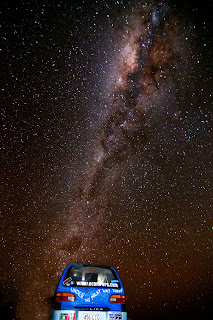 Uluru is the Pitjantjatjara name for Ayers rock, and possibly can be translated as "Earth Mother." Pitjantjatjara is the name of both an Aboriginal people of the Central Australian desert and the dialect of the Western Desert Language traditionally spoken by the Pitjantjatjara people.
Uluru is the Pitjantjatjara name for Ayers rock, and possibly can be translated as "Earth Mother." Pitjantjatjara is the name of both an Aboriginal people of the Central Australian desert and the dialect of the Western Desert Language traditionally spoken by the Pitjantjatjara people.There are many stories surrounding Uluru,. Some of the stories can be shared with the uninitiated (us), others are restricted men and women's stories that are only shared with those who need to know. Features of the rock are explained in the stories from the creation time (Tjukurpa) and are about the spirit ancestors of the Anangu, ( Aboriginal human beings). One story everyone who sees Uluru should know is the story of Kuniya, a young woma python, who was ambushed by a group of Liru (venomous snakes). The battle between Kuniya's enraged aunt and the Liru left scars on the rock that are visible today.
 Another story tells us:
Another story tells us:Blue-tongued lizard man, Lungkata, stole an injured emu from Panpanpalala, the crested bellbird man, during a hunt. This feature of the rock is his burned flesh (also shown in the photograph below), as he rolled down the face of Uluru after trying to climb high to his cave to escape a fire lit at the base of the rock.
These stories are lessons to teach us how to behave: don't steal!

 We walked the 10.6 km circuit Base Walk around Uluru, out of respect for the traditional owners wishes that we not climb the rock. The flowers were amazing.
We walked the 10.6 km circuit Base Walk around Uluru, out of respect for the traditional owners wishes that we not climb the rock. The flowers were amazing.Uluru gives life to the surrounding desert. that falls on her great surface pools at the base of the rock, quenching the thirst of the desert animals and plants. Shade cast from her enormous bulk also provides a resting place for the animals and plants, and respite from the heat.
"Escape the crowds and take a meandering journey through acacia woodlands and grassed claypans. Discover the diverse plants, animals and geological features of the park... Encounter bloodwoods, native grasses and many waterways. The Base Walk is the best way to fully appreciate the natural and cultural beauty of Uluru." ~Uluru Visitor's guide
 One of the rock art panels visible to outsiders. This one tells a number of stories including the best path between Uluru and Kata Tjuta.
One of the rock art panels visible to outsiders. This one tells a number of stories including the best path between Uluru and Kata Tjuta."This is where the Mala people camped when they first arrived at Uluru back in the beginning. There are many fine examples of Anangu rock art along this walk, and you can experience the
sheer vertical walls and profound peacefulness of Kantju Gorge." ~Uluru Visitor's guide
Mala are the rufous-hared wallaby; there are great efforts being undertaken in a breeding program to attempt to rescue the Mala from extinction and bring them back to the land of the ancestors. At present, there are too many feral predators that kill the wallabies to make this possible.
 Regarding the traditional owner's view on climbing Uluru:
Regarding the traditional owner's view on climbing Uluru:"That’s a really important sacred thing you are climbing… You shouldn’t climb. It’s not the real thing about this place. The real thing is listening to everything. And maybe that makes you a
bit sad. But anyway that’s what we have to say. We are obliged by Tjukurpa (traditional law) to teach people what behaviour is appropriate. It has been this way since the beginning. And all the tourists will brighten up and say, ‘Oh I see. This is the right way. This is the proper way: no climbing.’" ~Uluru visitor's guide
The day we hiked, the climb was closed due to winds at the top, anyway. You can see the cable stanchions in this photo.
 Uluru is sacred to the Pitjantjatjara. Interestingly, some knowledge is considered to be contextualand must not be transmitted outside where it can be directly observed. So photographs of parts of the rock are discouraged, as they would distribute knowledge (the photo) outside the context from which it can be seen (being there).
Uluru is sacred to the Pitjantjatjara. Interestingly, some knowledge is considered to be contextualand must not be transmitted outside where it can be directly observed. So photographs of parts of the rock are discouraged, as they would distribute knowledge (the photo) outside the context from which it can be seen (being there).It is an interesting concept about the privileging of knowledge which runs counter to all the technological forces at work in the world.

A White-breasted Woodswallow

The desert comes alive after the rains....














